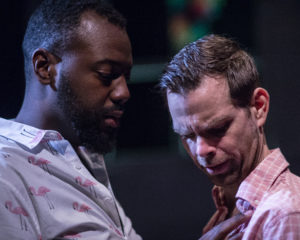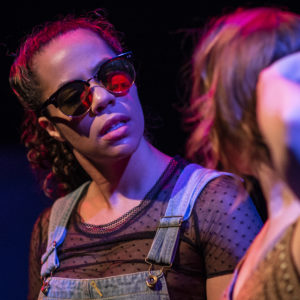The gender-flip trope has been a staple on stage for much of theater history, and just when you thought it had been trotted out every which way imaginable, along comes a delightful surprise. Brett Ableman’s Switch has so many original things to say, it could well make one see sex in a whole new way.
Produced by The Welders playwrighting collective—one of DC’s premier incubators of innovative theatrical storytelling—Switch is rich with insights and clever bits about embodiment, identity, and what turns folks on. And under the discerning direction of Megan Behm, the show’s frisky cast mines Ableman’s astute script for all it’s worth.
Set Designer Brian Gillick’s location already makes a statement: a building with three windows bedecked in rainbow bunting and boas (as if a Pride parade might pass by) and what becomes a very multipurpose bed.

Our spirit guide to the proceedings is a genderqueer sprite named Lark, played by nonbinary actor Tyasia Velines with so much ebullience and impish charisma one can believe they could cast a charm on anyone—which is exactly what they do to an unsuspecting couple of single thirtysomethings, Leila (Mary Myers) and Doug (Anderson Wells).
Lark fixes Leila and Doug up on date and, it being Pride weekend, they decide to go to the parade as straight allies. A romance quickens between them, and all indications are they’re headed for bed, either at his place or hers.
But first Lark lets the audience in on a whispered secret: When Leila and Doug have sex, their bodies will switch. Leila will be in Doug’s and Doug will be in Leila’s. And voilà, Ableman’s cunning premise is off and running.
The script is far more than a gimmick, though, because Ableman has crafted in Doug and Leila two characters who are not only credibly compatible but also committed to equality in a relationship, however much achieving such equity might get awkward. This quality of aspirational erotic ethics is as rare between characters onstage as between lovers in real life, but it shines through the luminous performances of Myers and Wells, whose moment-to-moment inner emotions seem intuitively tethered to their own and each other’s truth.

The bedroom scene in which Doug’s and Leila’s lovemaking becomes a transmigration of souls is a stunner, and I surmise the contribution of Intimacy Consultant Emily Sucher is the reason it works so wonderfully. Here and throughout the play’s several sex scenes, Switch plays like a master class in how to artfully emulate eros—and Switch is a compelling argument for always having someone such as Sucher in any rehearsal room where it happens.

A lot of the play is laugh-out-loud funny, as when, post-switch, Leila-in-Doug and Doug-in-Leila separately explore their new bodies’ genitalia. Examining his new labia, Doug feels like “an explorer or a pastry chef.” Examining her new scrotum, Leila wonders why it has two balls and supposes it’s because one would be lonely. She then on a whim tries to find out how a blow to her testes would feel. Wham. She doubles over in agony. “Who put the self-destruct button on the outside?!” she moans. With such sweet naivete leading up to Leila’s and Doug’s newfound understanding of each other, Switch shreds binary gender preconceptions and tosses them into the air like confetti.

Leila-in-Doug and Doug-in-Leila separately do some experimental same-sex cruising, because of course Leila, in Doug’s body, is still heterosexual, and Doug, in Leila’s body, is still straight. “Welcome to the rainbow side!” exclaims Lark, with genuine joy. Ensemble members Chloe Mikala and Matt Baughman do an engaging job as their gay hookups, including in some hilariously vivid homo-emulations of eros. Then, having had ostensibly same-sex experiences, Doug and Leila imagine separately what the same acts would feel like in ostensibly straight sex. “Imagine if I stuck my fingers in Doug’s ass,” Leila ponders. And Doug reflects that if he were with Leila as himself in Leila’s body, he would not have to “second-guess every move, because I’m not a guy in her eyes.” By this point, part of the fun of the play is just trying to keep from being confused about who’s in whose body with whose sexuality—which is slyly leading us to the point when Doug and Leila come to see each other in a brand new way.
Costume Designer Moyenda Kulemeka gives Lark shiny silver sneakers and an otherworldly tunic while keeping everyone else in realistically casual dating-scene attire—including when Doug and Leila simulate undressing. Lighting Designer Elizabeth Roth makes maximum use of minimal equipment to keep the unreal real. And Sound Designer Sam Cooper brings in playful pop music to set the multi-amorous moods.
While sharply observed in both text and acting, the show as a whole felt a little longer than it needed to be to be. With some judicious concision, it would play even better. But that’s a minor quibble on a formidable achievement: Because Brett Ableman’s Switch brings a fresh fun twist to what’s betwixt our ears and legs.
Midway through, Lark announces that Doug and Leila have till sunrise to orgasm again and revert to the bodies they were born in. Will they or won’t they? When you finally find out what they decide and why, you may well, as I did, get the feels.






These “freaky friday” stories never really succeed, likely because it’s a one-joke premise in which the gags are utterly predictable. “Switch” is no different, and sitting through an uninterrupted two hours of it is probably more than anyone should have to endure.